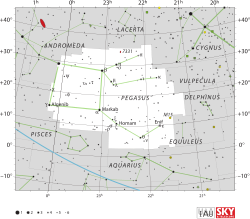أو إيتا الفرس الأعظم Eta Pegasi اسمه التقليدي Matar مشتق من الاسم العربي. و هو نجم ثنائي في كوكبة الفرس الأعظم.
| سعد المطر | |
|---|---|
سعد المطر في كوكبة الأعظم - النقطة الحمراء (η)
| |
| معلومات الرصد حقبة حقبة اعتدالان حقبة |
|
| كوكبة | الفرس الأعظم |
| مطلع مستقيم | 22س 43د 00.13743ث[1] |
| الميل | ° +30 ′13 ″16.4822[1] |
| القدر الظاهري (V) | +2.95[2] |
| الخصائص | |
| نوع الطيف | G2 II + F0 V[3] |
| U−B مؤشر اللون | +0.57[2] |
| B−V مؤشر اللون | +0.86[2] |
| القياسات الفلكية | |
| السرعة الشعاعية (Rv) | +4.3[4] كم/ث |
| الحركة الخاصة (μ) | –100.06[1]+15.46[1] |
| التزيح (π) | 19.51 ± 0.18 د.ق |
| البعد | 167 ± 2 س.ض (51٫3 ± 0٫5 ف.ف) |
| القدر المطلق (MV) | –1.18[5] |
| المدار | |
| الشذوذ المداري (e) | 0.183 |
| القبا عصر (T) | 2452025 HJD |
| البعد الزاوي الحضيضي (ω) (ثانوي) |
344.7° |
| نصف-مطال (K1) (أساسي) |
14.37 كم/ث |
| تفاصيل | |
| η Peg A | |
| كتلة | 3.82 ± 0.52[6] ك☉ |
| نصف قطر | 18[7] نق☉ |
| ضياء | 247[6] ض☉ |
| جاذبية سطحية (log g) | 2.40[8] سم.غ.ثا |
| درجة الحرارة | 5,450[6] ك |
| معدنية (فلك) [Fe/H] | +0.39[8] dex |
| دوران | 818[5] |
| سرعة الدوران (v sin i) | 1.4[9] كم/ثا |
| تسميات اخرى | |
| Matar, 44 Peg, فهرس النجوم الأساسية 857, فهرس هنري درابر 215182, هيباركوس 112158, فهرس النجوم 8650, فهرس النجوم 90734.[10] | |
ينتمي سعد المطر إلى الفئة الطيفية G2II-III و يملك قدر ظاهري 3.1+ و يبعد 215 سنة ضوئية عن الأرض. أما رفيقه ينتمي إلى الفئة الطيفية F0V . ضياء النجم الرئيسي يصل إلأى 262 ضعف من ضياء الشمس. يحتمل أن يكون سعد المطر عبارة عن مجموعة رباعية النجوم حيث أن النجمين الآخرين ذو ضياء قليل.[11]
مقالات ذات صلة
المراجع
- van Leeuwen, F. (November 2007). "Validation of the new Hipparcos reduction". Astronomy and Astrophysics. 474 (2): 653–664. arXiv:. Bibcode:2007A&A...474..653V. doi:10.1051/0004-6361:20078357.
- Johnson, H. L.; et al. (1966). "UBVRIJKL photometry of the bright stars". Communications of the Lunar and Planetary Laboratory. 4 (99): 99. Bibcode:1966CoLPL...4...99J.
- Parsons, Sidney B.; Ake, Thomas B. (November 1998), "Ultraviolet and Optical Studies of Binaries with Luminous Cool Primaries and Hot Companions. V. The Entire IUE Sample", The Astrophysical Journal Supplement Series, 119 (1): 83–104, Bibcode:1998ApJS..119...83P, doi:10.1086/313152
- Wilson, Ralph Elmer (1953). General Catalogue of Stellar Radial Velocities. Washington: Carnegie Institution of Washington. Bibcode:1953QB901.W495.....
- Pizzolato, N.; Maggio, A.; Sciortino, S. (September 2000), "Evolution of X-ray activity of 1-3 Msun late-type stars in early post-main-sequence phases", Astronomy and Astrophysics, 361: 614–628, Bibcode:2000A&A...361..614P
- Hohle, M. M.; Neuhäuser, R.; Schutz, B. F. (April 2010), "Masses and luminosities of O- and B-type stars and red supergiants", Astronomische Nachrichten, 331 (4): 349, arXiv:, Bibcode:2010AN....331..349H, doi:10.1002/asna.200911355
- Lang, Kenneth R. (2006), Astrophysical formulae, 1 (الطبعة 3), Birkhäuser, . The radius (R*) is given by:
- Luck, R. Earle; Wepfer, Gordon G. (November 1995), "Chemical Abundances for F and G Luminosity Class II Stars", Astronomical Journal, 110: 2425, Bibcode:1995AJ....110.2425L, doi:10.1086/117702
- Massarotti, Alessandro; et al. (January 2008), "Rotational and Radial Velocities for a Sample of 761 HIPPARCOS Giants and the Role of Binarity", The Astronomical Journal, 135 (1): 209–231, Bibcode:2008AJ....135..209M, doi:10.1088/0004-6256/135/1/209
- "MATAR -- Star in double system", SIMBAD Astronomical Object Database, Centre de Données astronomiques de Strasbourg, مؤرشف من الأصل في 11 يناير 2020,03 مارس 2012
- "Tabulae Astronomicae" (1727), see star table, page 13. - تصفح: نسخة محفوظة 26 يناير 2020 على موقع واي باك مشين.


